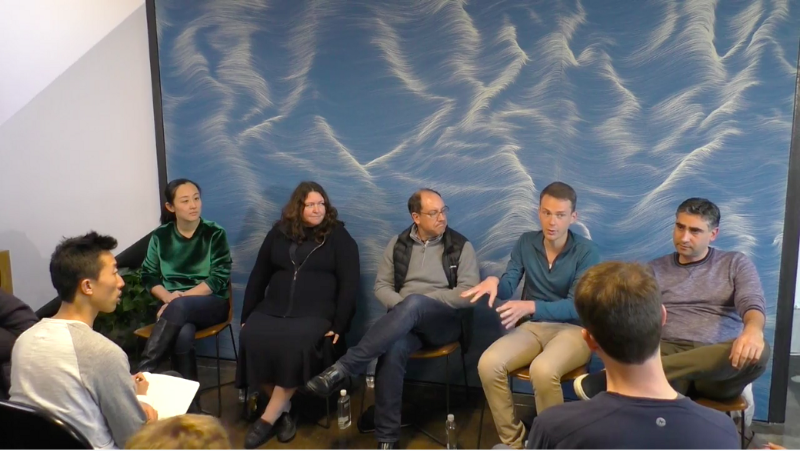Investing in AI: Lessons from Silicon Valley VCs
As part of the regular speaker series at South Park Commons, Andreessen Horowitz’s Martin Casado, Felicis Ventures’ Aydin Senkut, Y…

As part of the regular speaker series at South Park Commons, Andreessen Horowitz’s Martin Casado, Felicis Ventures’ Aydin Senkut, Y Combinator’s Daniel Gross and Basis Set Ventures’ Lan Xuezhao gathered in April to chat about their strategies around investing in AI companies. From their evaluation criteria for AI startups to their short-term and long-term outlooks for the space, the group dug into both the challenges they’ve faced as investors and the rewards they’ve reaped from successful AI bets.
We’ve distilled the key insights from the conversation for you here. Whether you’re an investor, a startup founder, or just interested in the future of AI — here’s what we learned.
Lean into the hype
For the past several years, ‘AI’ has been a popular buzzword. A venture capitalist’s advice? Lean in and don’t waste a good bubble.
“At the end of the day hype is just a way to concentrate human attention to a particular domain,” said Y Combinator Partner Daniel Gross. In this case, hype has concentrated attention on AI, not only drawing funding to AI companies but also enabling these companies to recruit top talent and secure partnerships with mature companies.
“With companies I sit on the board of, it’s been really surprising to see how deep the engagements are that they have with mature companies in production, on the line or in manufacturing,” said Andreessen Horowitz general partner Martin Casado. “A lot of that is because there is so much halo around AI in general. Lean in to the hype. You can get meaningful engagement and [mature companies] will push you in production because there’s so many internal AI initiatives.”
Valuations for AI companies will be impacted by the computational requirement
How does a VC decide whether or not an AI company is worth investing in? For many, they apply the same rubric that they would for any startup, because AI is more of an efficiency hack than anything else. Most AI use cases are application repetition to replace what humans can do.
However, as AI companies move from human labor, they add a variable cost in AWS, which can be even more expensive. This cost not only impacts a company’s margins but will ultimately impact valuations for AI companies relative to software companies.
“We’re grappling with this internally because we have a number of examples of companies that are solving real problems, have tons of revenue, but poor margins because of the computational requirement,” said Casado.
VC firms are still interested in making these type of investments, but the question becomes how to value those investments over time. The answer might be investing in different parts of the supply chain — such as AWS optimization — and then valuing that asset accordingly.
Applications of AI and the diligence process
Each of the investors we spoke to have different views on what makes an attractive AI investment, but they agreed that a successful AI company uses AI for a specific purpose instead of just an add-on feature.
For this reason, Gross explained that, at Y Combinator, they screen for AI startups in the same way they would for any other company.
“When people come in to interview, if they’re thinking of applying AI or machine learning to a particular domain like law, accounting, robotics, we’ll do the same test we do with any founder who wants to build a vertically integrated company — which is we’ll ask them a lot of questions about it,” said Gross.
Felicis Ventures Founder and Managing Director Aydin Senkut’s interest area lies in AI companies with a proprietary data element.
A number of Felicis’ AI investments didn’t start as AI companies, but by building a unique data asset (like SoundHound did with conversational data), they ended up in a place where AI has a specific purpose. On the other hand, some of their best AI investments have also been the companies “that seem so crazy that we almost didn’t invest.”
How AI startups can compete with tech giants
Some of the most interesting (and biggest) AI companies are Google, Amazon and Facebook, so building an independent AI company can seem daunting without unlimited money and resources. Here’s what investors recommend when it comes to competing with FANG:
Focus on verticalized solutions
By focusing on verticalized solutions it’s easier to find vertical applications of AI. FANG isn’t focused on narrow use cases, such as agriculture, as it’s harder for them to move outside of their core business. So there’s an opportunity to go deep and create vertical solutions.
Go up the stack
Investors suggest going up the stack to get massive markets and fragmentation.
“If you’re lower in the stack, you’re always at risk of commoditization,” said Casado. “Whoever gets commoditized last wins. You definitely need to move up the stack, but if you see a real problem and a real technology don’t be afraid of it.”
Focus on regulated markets
Focusing on regulated markets can mean more difficulty but it can also mean there are deep moats.
The takeaway
In short, we learned that capitalizing on the current AI market means leaning into the hype, understanding how the computational requirement might impact valuations, and seeking AI companies with unique and defensible applications.
South Park Commons is a community that helps entrepreneurs and technologists freely learn, explore new ideas, and start ambitious projects. Want to tell us what you’re thinking about and working on? Learn more about our community here.
